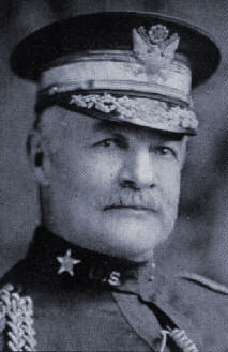
Hunter Liggett, circa 1914 |
During World War I, Major General Hunter Liggett served as a division, corps and army commander in
the American Expeditionary Forces (AEF). When he assumed command of the US First Army in autumn
1918, he had already served in the Army for more than 39 years. Before the war, he held a wide variety
of operational assignments, including battalion and brigade command. More important, he actively and
continuously studied to prepare for future war. This preparation for "the next war" served Liggett well
in the severe test amid the trenches of France.
Liggett's ceaseless preparation allowed him to break free of the stereotypical, unimaginative generalship
that too often characterized World War I commanders. His study and reflection of nearly four decades
allowed him to rise above his personal assignments and develop practical solutions to modern war's
complexities. This was nowhere more apparent than in Liggett's establishment of a modern, effective
command environment. His personal preparation also reflected itself in the great care he took in
preparing his units for operations. Throughout his career, Liggett's leadership remained firmly balanced
upon the twin pillars of taking care of soldiers and his own admirable character.
Early Career
After graduating from the US Military Academy in 1879, Lieutenant Liggett joined the Fifth Infantry on
the Montana frontier. For most of the next two decades, he served with the same regiment in the West.
Despite his long frontier service, Liggett was never involved in any major Indian campaigns, although he
did earn the Indian Campaign Badge. In one small skirmish, Liggett's regimental commander
commended his leadership. In 1892, Liggett left the West with his regiment when it was posted to
Florida.
Historian Edward M. Coffman noted that early 20th-century US Army officers prepared for war through
operational experience, institutional schooling and training maneuvers. Liggett, to one degree or
another, used all three means. Although he missed combat in Cuba, he served there briefly during active
operations. Then from 1899 to 1902, he served in command and staff positions in the Philippines during
the insurrection. Returning to the United States, he became the Department of the Lakes adjutant general
in Chicago. In 1907, he assumed infantry battalion command in the 13th Infantry, stationed at Fort
Leavenworth, Kansas.
While at Fort Leavenworth, then Lieutenant Colonel Liggett began his education in the newly founded
Army education system. "Though not detailed as a student," Liggett later wrote, "I managed to assimilate
most of what the School of the Lines and the School of the Staff had to offer." He did this through
association with instructor, then Lieutenant George C. Marshall. As Marshall described it, he "would
give [Liggett] the problem after the class got it. Then I would go over his work, correct his work, after I
had the approved solution." Through this covert approach, Liggett gained an appreciation for
regimental and divisional tactics.
As a 1910 Army War College (AWC) class member, Liggett built on the foundation of his Leavenworth
"course." At the AWC, he prepared for duty on the general staff and learned the tasks of commanders
and staffs of larger troop formations. These two schools were particularly important to Liggett and his
colleagues. Serving only in small units of a relatively small army, US Army officers relied on the
theoretical school instruction to learn the methods of large-scale modern war. However, equally
important to Liggett were the associations he made at the schools: Malin Craig, an AWC classmate, later
served as Liggett's World War I chief of staff, and Marshall served as Liggett's chief of operations.
Upon graduation, Liggett became the AWC director, and later, its president. As the AWC director, he
was instrumental in reshaping its curriculum along the lines of the Leavenworth schools, adding
instruction in military history, operational planning and general staff duties. Concurrently, he served as
the chief of the primary planning agency on the general staff. In this position, Liggett prepared plans for
interventions into Mexico, and he considered ways to improve Philippine defenses. While serving on
the general staff, Liggett also participated in peacetime training maneuvers - in particular, the 1912
Connecticut Maneuvers, which were noted for their use of "after-action reviews."
From 1907 to 1913, Liggett studied the supply, organization and command of higher units, planning
their use through war plans. From 1913 to 1921, he exercised the knowledge he had gained through a
variety of active commands ranging from brigade through field army.
After commanding the administrative Department of the Lakes, Brigadier General Liggett assumed
command of the Fourth Brigade (Infantry) in 1914. Stationed along the Mexican border as part of the 2d
Division, Liggett experienced "actually handling a brigade in the field." Convinced that a conflict with
Mexico was inevitable, Liggett made every effort "to instruct the officers and soldiers [so] that they
would be able to take care of themselves, no matter what preponderance force in numbers we might
encounter in Mexico." To do this, Liggett designed a series of training problems based on actual
contingency plans. As part of the training, he had his men construct trench lines and strongpoints. He
then used those obstacles as objectives for night attacks. In all of his training, Liggett emphasized the
combination of arms - he used artillery, engineers and signal troops to support his infantrymen. One of
Liggett's regimental commanders, Colonel Robert L. Bullard, who later became a fellow corps and army
commander in the AEF, thought the training exercises were the most realistic and useful training that he
had seen in the Army. At Fourth Brigade, Liggett demonstrated the innovation and practical preparation
that would mark his future commands.
In 1915, he arrived in the Philippines to take command of the 1st Infantry Brigade (Provisional). There
he continued to stress training and preparation for war. Together with his aide, Captain George C.
Marshall, Liggett conducted tactical instruction and exercises. In particular, he used staff rides to
familiarize commanders with the tactical possibilities in defending the island, and he found "the study
and practical working out of the problems of defense were most instructive." In April 1916, Liggett
assumed command of the entire Philippines Department, the Army's largest overseas command. A
month before America entered World War I, he was promoted to major general, one of only seven in the
Army.
After the US declaration of war in April 1917, Liggett returned to the United States to command the
Western Department, and in September, he assumed command of the 41st Division.
Corps Command
Before he had been in command for a month, Liggett was ordered to France to tour the Western Front to,
as Liggett put it, "inform ourselves at first hand what was in store for us." He inspected both the British
and French methods of trench warfare and watched the planning and execution of a British attack against
Passchendale Ridge, making mental notes on tactics, organization, training, methods of supply and even
morale. The group of 15 major generals and their chiefs of staff also visited the AEF headquarters at
Chaumont.
General John J. Pershing, the demanding AEF commander, conducted a medical survey and character
analysis at Chaumont. Normally, he found the generals too old or inactive, or otherwise not up to the
rigorous demands of the Western Front and quickly sent them back to the United States. Liggett could
have easily been dismissed on those grounds himself, since he was 60 years old. Yet Pershing must have
seen something in Liggett and decided to keep him in France. Liggett recognized that his weight might
have been a concern with Pershing and later commented, "I never have inquired, and the reports continue
to be only hearsay to me, but unquestionably there is such a thing not only as being too old to fight but
too fat. That disqualification is the more serious if the fat is above the collar."
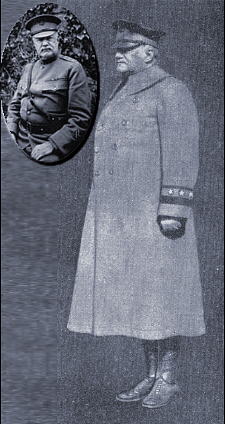
During the War:
Undeniably Stout
But No "Fat Above the Collar" |
Initially, Pershing recommended Liggett as the American military representative on the Supreme War
Council, the Western Allies' political and military forum. When Secretary of War Newton Baker selected
General Tasker Bliss for that position, Pershing named Liggett US I Corps commander in January 1918.
When he took command of the corps, he assumed administrative control of four US divisions, only
one of which was on the front lines. Consequently, over the ensuing months, Liggett and his staff
supervised the divisions' training, equipping and supplying, making frequent inspections and tours.
Although the French retained tactical control of his divisions, Liggett often acted on his division
commanders' behalf and argued to make tactical adjustments, if necessary. More important, he used this
time to prepare his corps for war. He and his staff studied the military situation, especially in the
southern portion of the line, which would later become the American sector. "The time from January
20th to June 1918," Liggett noted, "was well utilized in bringing the Corps Staff up to the state of
efficiency which later distinguished it in all work."
For the first six months of 1918, a growing number of US divisions took over active sectors on the line,
but I Corps did not. Before the German offensives of March and April 1918, Pershing had planned for
the corps to take over the quiet Toul sector. A series of German offensives forced Pershing to use
American troops to bolster the Allied fronts. The result was that the US divisions, although still
administratively controlled by Liggett, fought under the tactical control of French or British
commanders. Liggett waited patiently. As Coffman, the best AEF historian, remarked, Liggett "was no
prima donna, however; he could wait for opportunity with equanimity." The waiting ended in July
1918.
Early Battles: July to September 1918
On 4 July 1918, over a year after American troops had first landed in
France, Liggett's I Corps took over an active sector northwest of
Chauteau-Thierry. The sector was at the apex of a bulge in the Allied
lines left from the Germans' recent spring and early summer
offensives. Two weeks after assuming the position, I Corps
counterattacked, as part of the French Sixth Army, toward the Vesle
River. Despite their inexperience and fierce German counterattacks,
Liggett and his corps were more successful than the flanking French
corps. "From the very beginning of the fighting," Liggett later wrote,
"all commanders were warned about the futility of making the front
lines too heavy, and all were enjoined to attack machine guns by
envelopment and never directly." By 5 August, I Corps, now flanked
by fellow US III Corps, reached the Vesle. For the next six weeks, I
Corps remained on the defensive as the Allies prepared for a general
offensive against the Germans.
Before this offensive was undertaken, the newly formed US First Army, under Pershing's direct
command, would launch an attack to erase the four-year-old St. Mihiel salient. The operations order
called for Liggett's corps and Major General Joseph Dickman's IV Corps to attack northward to link up
with Major General George Cameron's V Corps advancing from the south. A French corps would
conduct holding attacks against the nose of the salient.
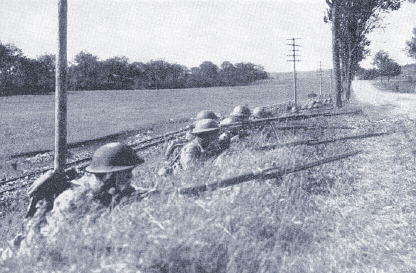
42nd Division Patrol During St. Mihiel Offensive
A few days before the battle, Liggett called his division commanders together, and "every detail of the
approaching battle [was] carefully explained." Liggett and his commanders thoroughly reviewed the
written order to ensure that each subordinate commander fully understood not only his mission, but
those of the divisions to the right and left. This was particularly important, since he told his commanders
to press their units forward without checking alignment with flanking divisions, as long as their flanks
were not unduly exposed. For I Corps, Liggett later wrote, "the advance was to be continued until stopped by
the enemy." He clearly pointed out what he saw as the decisive point of the battle - the ground north of
Thiaumont. Liggett also stressed the need to keep the front-echelon attack relatively weak, with a strong
reserve out of German artillery range.
With three divisions in the lead and one in reserve, Liggett's corps attacked on 12 September. With his
commanders fully informed of his desires, Liggett's attacking columns moved quicker than anticipated.
In less than four days, I Corps had reached its final objectives and, in the process, captured almost 5,000
prisoners and over 130 guns, with minimal casualties. Within 10 days, Liggett and his corps would begin
a more serious test, against a more determined enemy.
Meuse-Argonne: 26 September to 14 October 1918
As part of the general Allied offensive to drive Germany out of France, US forces were to attack into the
heavily defended Meuse-Argonne region. The American objective was the German lines of
communication running through Sedan and Metz. To reach this, Pershing and his First Army staff
planned for three corps, consisting of 12 divisions, to rapidly advance on line, seeking to overrun the
German main defenses before they could be reinforced. Cameron's V Corps was to attack in the center to
seize the key terrain of Montfaucon Hill, while Bullard's III Corps and Liggett's I Corps would drive
deep on a flank and force the enemy to withdraw. The attack was scheduled for 26 September.
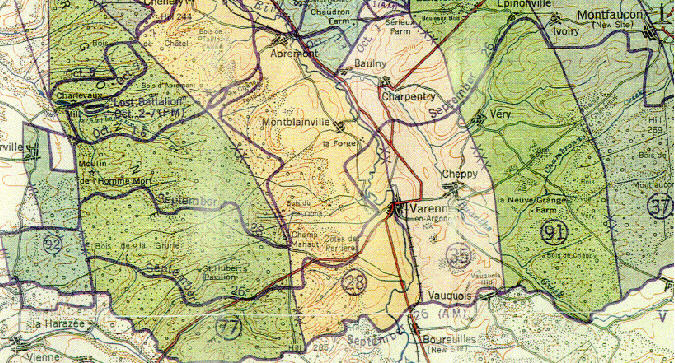
I Corps Area At the Start of the Meuse-Argonne Offensive
Pershing assigned Liggett the western sector anchoring First Army's flank. Unfortunately for Liggett and
his troops, their sector included the forbidding Argonne Forest. "The region," Liggett later noted, "was a
natural fortress while the Virginia Wilderness in which Grant and Lee fought was just a park."
Moreover, because the St. Mihiel operation had concluded only 10 days earlier, the Americans were
unable to use the veteran divisions from that battle for the Meuse-Argonne's opening stages, resulting in
unfamiliar command arrangements. Of I Corps' four divisions, none had served under Liggett before late
September.
Despite these problems, I Corps made reasonably good initial progress. Using his characteristic
encircling attacks rather than direct frontal assaults, Liggett circumvented the most formidable defenses
and drove nearly 4 miles up the Aire River valley on the first day. Army orders to stop along an objective
line, however, stalled I Corps' momentum. That delay and German reinforcements slowed the American
advance over the next several days. Faced with the strongest German lines, Pershing had to suspend
forward movement on 30 September.
The US First Army resumed its advance on 4 October with an attack aimed at the German defenses
along the Cunel and Romagne Heights. The attack made little headway against the well-organized
German machine gun and artillery defenses. As David Trask, former Army chief historian, points out,
"Only the I Corps made a useful advance, positioning itself to penetrate the Argonne." Pershing ordered
more attacks 7 October and again 14 October. They made only limited advances against stiff German
resistance, formidable terrain and increasing logistic and tactical difficulties.
In the midst of these weeks of frustrating attrition so typical of the war's trench warfare, Liggett showed
his characteristic tactical sense with a bold and innovative attack that cleared the Argonne Forest.
Throughout early October, Liggett's troops had advanced far enough to enable a blow against the
Argonne's northwest flank, rather than more frontal assaults. Thus, Liggett proposed a division attack to
move past the German defenses. The attack was risky - it moved perpendicular to the rest of the
American advance and was subject to converging fires and having its northern flank exposed. So bold
was this plan that the French liaison officers and most of Liggett's own staff opposed it. Only Colonel
Craig, his chief of staff, supported him. Yet against this opposition, Liggett proposed it to Pershing's
chief of staff, Major General James McAndrew, who authorized it. On 7 October, Liggett launched the
attack and succeeded in forcing the Germans out of their Argonne defenses. [Ed. This attack relieved the "Lost Battalion" and was the occasion of Alvin York's heroism.]
With mounting pressure from Allied leadership and increasing logistics problems, Pershing decided to
relinquish First Army command. In early October, Pershing had intimated that he would turn over
command to Liggett; nine days later, he called Liggett to First Army headquarters to take command
immediately. There, Liggett learned of the planned 14 October offensive. Rather than take charge in the
midst of a major operation, Liggett asked if he could assume command after the planned operation had
been completed. Furthermore, it would give him a chance to learn the condition of the army.
Remodeling an Army: 16 October to 1 November 1918
As the Americans attacked, Liggett visited the corps and division headquarters to learn the "conditions
on the line, the temper of the troops, and their commanders." Liggett was "acquainted with everything of
this kind on the First Corps front, and now needed the same knowledge as to the entire line." After he
assumed command on 16 October, Liggett and his staff continued these visits for two more weeks. Not
only were they looking for ways to "tighten up," they made "every effort to profit [from] past mistakes
and encourage the fighting spirit of the army for the impending attack."
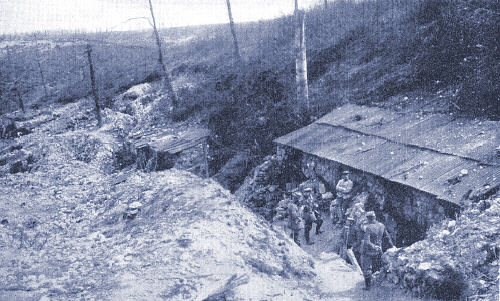
German Dugouts in the Argonne Forest
The German Army Had Fortified the Sector for Four Years
What Liggett and his staff found as they visited the First Army was not good. One American staff officer
called it "a disorganized and wrecked army." All of the divisions were tired and depleted from the weeks
of bitter fighting. Several divisions were combat-ineffective, with less than 25 percent of their authorized
strength. Liggett estimated that there were over 100,000 stragglers, draining the army's strength. A lack
of draft animals immobilized the army's artillery. The army needed to rest and refit, so for the next two
weeks, Liggett allowed it to do just that and resisted pressure to do otherwise.
More important, however, Liggett retooled and remodeled First Army. Starting within his headquarters,
he strengthened his staff with officers such as Colonel George C. Marshall, his G3, and then met with
his staff daily. To prepare First Army for the impending attack against German defenses, Liggett
retrained his infantry and artillery. Some infantry received special training in techniques for attacking
strongpoints, while the rest were trained to bypass these defenses. Artillery batteries laid out supporting
plans to use interdicting fires to isolate infantry objectives and to conduct counterbattery fires against
German artillery. Perhaps the key factor was that commanders were indoctrinated in maximizing
supporting fires and using gas to suppress enemy defenses.
As Liggett prepared his three corps for future operations, he was under constant pressure from Pershing
to resume the offensive. Liggett resisted the pressure and told the AEF commander that First Army was
too exhausted for any major assault. Finally, after Pershing persisted in hanging around the First Army
headquarters at Souilly, Liggett had to tell him to go away and forget First Army's problems.
Although Liggett did not want to launch a major attack until he had remodeled his army, he believed that
"further local advances were essential to secure the best possible line from which to launch [First
Army's] general attack." All three corps launched local attacks to clear forests, seize hills and otherwise
secure favorable positions. The bloodiest of these local operations was I Corps' 10-day battle to capture
Grandpré on 27 October.
As the battle for Grandpré raged, Liggett met with General Henri Gourand, the French Fourth Army
commander. The American told the French general that he would be ready to attack on 28 October, but
Gourand said he could not attack until 2 November. The Allies finally agreed on 1 November, a delay of
four days. Liggett wisely used the delay to "have everything in complete readiness."
In the four days before opening the offensive, First Army readied itself for the upcoming attack. In the
rear, service troops stockpiled supplies and repaired roads. Artillery placed fires on suspected and known
enemy artillery and reserve positions. In the front lines, units made their combat checks and final
preparations. Meanwhile, Liggett, as was his habit, called in his subordinate commanders and
coordinated their plans. With the corps commanders and their chiefs of staff, Liggett went over every
detail of the plan. He also made his commander's intent clear: reach the ridgelines on the first day to
preclude the possibility of a counterattack. As a result of Liggett's painstaking preparations, confidence
permeated the First Army, and Liggett recalled "nobody had any doubt about the success of the coming
drive."
Into Battle: 1 to 11 November 1918
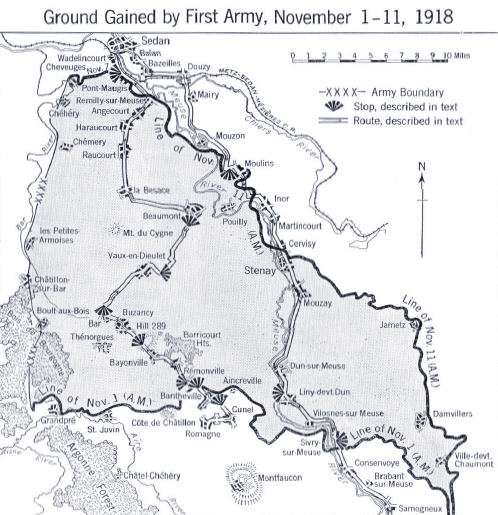
The Advance Made By Liggett's First Army After November 1st
(The Bottom of the Map Was Approximately the September 26th Jump-Off Line)
On 1 November, Liggett's First Army attacked northward toward the Meuse River. Liggett's main
objective was the Barricourt Ridge in the center, a realistic advance of 5 miles. Then he would thrust
west to outflank the Bougogne Forest, turn northeast and drive to the river. To accomplish this mission,
Liggett had a powerful instrument in First Army - with a strength of one million men supported by over
4,000 artillery pieces. Every corps had solid leaders and experienced staffs, and all of Liggett's divisions
were seasoned veterans.
On the first day, V Corps in the center easily gained control of the Barricourt Heights, while III Corps, in
the east, kept pace and advanced to the Meuse River. Only I Corps, in the west, failed to make much
progress. When Pershing expressed concern about I Corps' lack of success, Liggett remarked that "there
would be no enemy in front of the corps the next day." Liggett was right, and the next day, I Corps
succeeded in outflanking the Bougogne Forest and clearing the French Fourth Army's flank. Over the
next several days, Liggett's army continued to advance as fast as it could displace its artillery and
supplies forward. At one point, the advance was so rapid that it ran off the AEF headquarters' maps. By 4
November, Liggett had elements along the heights overlooking the Meuse.
Liggett's preparations paid off. Infantry and artillery coordination was superb. Troops pushed through
and around German strongpoints, while special assault troops reduced them. Improved staff work and
coordination afforded First Army the flexibility to bypass German defenses. "In contrast to former
attacks," commented Pershing biographer Donald J. Smythe, "in which a fairly good first-day advance
was followed by increasingly smaller ones, this attack was different. The third day's gain exceeded those of the first. The Army not only had an initial punch; it reached the point where it could keep going."
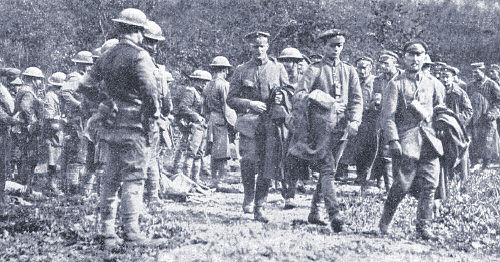
German Prisoners in the Battle's Late Stage
A week after Liggett's forces reached the Meuse, the Armistice was called. Under Liggett's tutelage, the
American units had finally developed into a well-trained, well-organized fighting force.
A Professor of War and Human Nature
Throughout his career, Liggett succeeded because, as his AEF colleague Bullard noted, "He knew how
to do it." This knowledge came from Liggett's continuous and thorough preparation for war. As Liggett
himself wrote, "It behooves all officers of whatever grade to fit themselves, by unceasing thought and
study, for the exercise of command. No one knows how soon his services may be urgently required in
defense of his country. Much can be learned from an intelligent study of military history, and no one can
be too well prepared for the great responsibilities of war."
This unceasing study of war was especially important for Liggett, since it allowed him to break free from
the stagnation of the small, frontier army that he entered in 1879. Although he spent the first 20 years of
his career in an army where the largest tactical unit was a regiment that only rarely got together for
training and employment, he was able to successfully command a division, corps and army during World
War I. When he served with the Fifth Infantry, he fought with horse cavalry and single-shot Springfield
rifles, yet in 1918, he was able to integrate heavy artillery, machine guns and tanks. As British military
theorist and historian B.H. Liddell Hart noted, "Liggett had preserved himself from stagnation by his
interest in reading."
Liggett's personal preparation for war took two forms: schools and reading. After 1907, he took advantage of the growing Army officer educational system. Although he never "attended" the Leavenworth schools, through his friend, George Marshall, he was able to gain an appreciation for the doctrinal approach to regimental and divisional tactics. Then he attended the AWC, where he learned about the operations of larger units. The thread that provided Liggett with continuity in his military education, however, was not the schools, but his own reading and study program. He examined the campaigns of Napoleon and Helmuth von Moltke the Elder. More important, he studied the American Civil War, arguably the first modern war.42 Yet unlike some of his peers, Liggett's theoretical preparation for war took a decidedly practical form in the field.
When Liggett commanded a unit, he took great care in preparing it for battle. In both prewar brigades he
commanded, he used realistic training exercises, staff rides and war games to ready them for war. When
he assumed I Corps command in January 1918 and waited six months for an active sector, he used the
time to train his corps staff. He also established corps schools for specialized training programs. His
remodeling and retraining of First Army in October 1918, however, remains the greatest illustration of
his painstaking preparation of units for battle. It also showed the results of both his personal and unit
preparation: a well-orchestrated and successful operation in November 1918.
Liggett's personal preparation also resulted in an effective, modern command environment that
combined his effective use of staffs, a personal awareness of the current situation and his subordinates'
clear understanding of the operational plan.
During the war, Liggett placed great importance on having an effective staff. He believed that for "a staff
to be effective [it] must possess ability, loyalty and military character, and, to produce the best results, it
must be harmonious. To secure the loyalty of his military subordinates, a commander must set the
example of perfect loyalty to his superiors. There is no place in the military profession for envy and
jealousy." While valuing teamwork, Liggett also demanded that his staff relieve him of the required
detailed planning and management, so he could concentrate on the commander's duties. By empowering
his staff to deal with the minor matters, he could concentrate on commanding, coordinating and training
his men. Yet, while he relied heavily on his staff, Liggett - unlike many AEF commanders - was never
overshadowed or overpowered by them, as demonstrated by his decision for the flanking attack against
the Argonne Forest in October 1918.
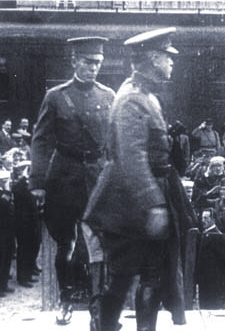
George C. Marshall and Hunter Liggett
in France 1918 |
By relying on his staff to run the daily routine business, Liggett could stay in touch with the current situation on the front. Of his visit to the British front in autumn 1917, Liggett wrote, "The first thing I determined to my own satisfaction at the Front was that a general officer has nothing to learn in the front lines. . . [T]he nearer one gets to the first line, the less one sees. The perspective is smothered in the close-up." Ironically, Liggett spent much of his time visiting the front. In one case, through his personal observation during the St. Mihiel operation, he became convinced that a forested area was hiding an enemy strongpoint, and he directed troops to outflank the forest rather than assault it directly. More often than
not, however, Liggett visited his subordinate commanders at their advance headquarters. As a corps commander, he kept his advance headquarters practically abreast of the division headquarters so he
could properly control the battle. Whether he was visiting the front lines or his subordinate commanders, Liggett's frequent visits forward allowed him to remain in touch with the actual situation and conduct his operations accordingly. Consequently, his operations were marked by a flexibility uncommon among AEF commanders.
Throughout his World War I operations, Liggett worked hard to make sure that his subordinates clearly
understood the operational plan and their role in it. "It is always possible," Liggett noted, "to misinterpret
a written order, either as to what is expected of you or of your neighbor." Before every major operation,
he would assemble his subordinate commanders, often with their chiefs of staff, and review the plan,
explain their roles and his intent. At these conferences, he often offered tactical guidance to his
commanders, especially in methods to prevent the useless loss of life.
Although developed by his preparation for war, and exercised through his effective command
environment, Liggett built his generalship upon the twin pillars of taking care of his soldiers and his own
character. Liggett clearly recognized that soldiers stood at the center of all military operations. "No
matter how much the machinery of war may be developed," he noted, "in the final analysis it is the man
we must understand. Man, with all his strengths and all his weaknesses, always has been and always will
be the basic element." To take care of that basic element, Liggett tried to ensure that his soldiers were
properly supplied. Moreover, Liggett paid close attention to safeguarding and protecting his soldiers. He
exhorted his commanders to keep their front lines relatively weak to prevent useless exposure to enemy
artillery and machine gun fires, and to attack strongpoints indirectly rather than frontally. Furthermore, he
used any and all measures to support his advancing riflemen. Once, he even authorized the use of skunk
gas, because he thought it would force the Germans into gas masks, allowing our troops to attack
unimpeded. Normally, however, he emphasized the more traditional supporting arms - artillery, tanks
and airplanes - to enhance his firepower.
Compassion for his troops was only one aspect of Liggett's truly admirable character. Retired Major
General Frank D. Baldwin, a winner of two medals of honor, said that Liggett "has no equal in
professional ability or noble character among our American generals." He was loyal to subordinates and
superiors alike. Tactful and good-humored, he was able to appreciate another man's point of view, yet
remain firm in his own convictions. Fellow army commander Bullard remarked that Liggett "had the
valuable faculty of seeing what was important and what not." Yet, above all, Liggett lacked
self-centeredness. Instead of concentrating on his own aggrandizement and position, he usually just went
about the task at hand, which invariably revolved around preparing for war.
Liggett offers the modern officer a singular perspective on leadership. Although he displayed attributes
common to most prominent generals - tactical competence, personal leadership and boldness in battle -
his most outstanding feature was the great effort he took to prepare himself for future war. Although he
received some assistance from a newly formed Army education system, most of this preparation came
through his own study and reading program. Through his ceaseless study and reflection on war, Liggett
was able to transcend personal experience, constrained resources and contemporary technology to grasp
military art's essentials. Consequently, instead of reacting to change in an unimaginative way, he could
readily adapt to those changes and produce innovative methods. He applied his personal attitude of
preparation to his units in practical, realistic training and careful planning. While the example of
Liggett's command environment will serve modern officers well, perhaps more valuable is the model of
his unceasing thought and study to prepare for war.
Thanks and Credits
Michael Bigelow's article first appeared in the on-line version of the U.S. Army journal,
Military Review, which we linked to for years. However, since it is no longer accessible for the general public on-line, Michael has given us his permission to present it on the
Doughboy Center. A retired Army officer, he is a graduate of the US Army Command and General Staff College, where he was named the 1997 Father Smythe Award winner. Images and maps shown here are from the US Army Signal Corps and
American Armies and Battlefields in Europe.









